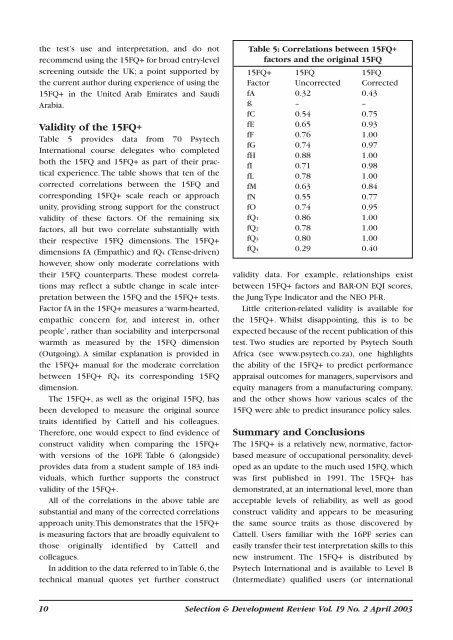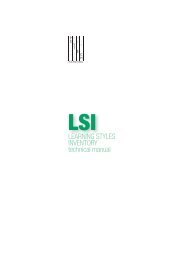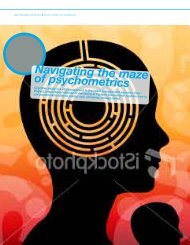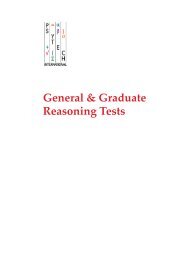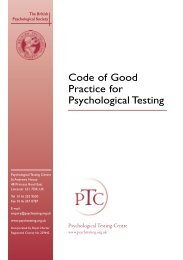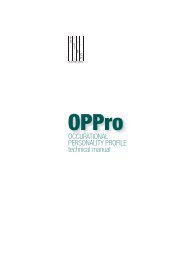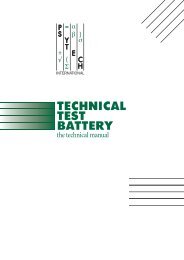A review of the 15FQ+ Personality Questionnaire
A review of the 15FQ+ Personality Questionnaire
A review of the 15FQ+ Personality Questionnaire
- No tags were found...
Create successful ePaper yourself
Turn your PDF publications into a flip-book with our unique Google optimized e-Paper software.
<strong>the</strong> test’s use and interpretation, and do notrecommend using <strong>the</strong> <strong>15FQ+</strong> for broad entry-levelscreening outside <strong>the</strong> UK; a point supported by<strong>the</strong> current author during experience <strong>of</strong> using <strong>the</strong><strong>15FQ+</strong> in <strong>the</strong> United Arab Emirates and SaudiArabia.Validity <strong>of</strong> <strong>the</strong> <strong>15FQ+</strong>Table 5 provides data from 70 PsytechInternational course delegates who completedboth <strong>the</strong> 15FQ and <strong>15FQ+</strong> as part <strong>of</strong> <strong>the</strong>ir practicalexperience. The table shows that ten <strong>of</strong> <strong>the</strong>corrected correlations between <strong>the</strong> 15FQ andcorresponding <strong>15FQ+</strong> scale reach or approachunity, providing strong support for <strong>the</strong> constructvalidity <strong>of</strong> <strong>the</strong>se factors. Of <strong>the</strong> remaining sixfactors, all but two correlate substantially with<strong>the</strong>ir respective 15FQ dimensions. The <strong>15FQ+</strong>dimensions fA (Empathic) and fQ4 (Tense-driven)however, show only moderate correlations with<strong>the</strong>ir 15FQ counterparts. These modest correlationsmay reflect a subtle change in scale interpretationbetween <strong>the</strong> 15FQ and <strong>the</strong> <strong>15FQ+</strong> tests.Factor fA in <strong>the</strong> <strong>15FQ+</strong> measures a ‘warm-hearted,empathic concern for, and interest in, o<strong>the</strong>rpeople’, ra<strong>the</strong>r than sociability and interpersonalwarmth as measured by <strong>the</strong> 15FQ dimension(Outgoing). A similar explanation is provided in<strong>the</strong> <strong>15FQ+</strong> manual for <strong>the</strong> moderate correlationbetween <strong>15FQ+</strong> fQ4 its corresponding 15FQdimension.The <strong>15FQ+</strong>, as well as <strong>the</strong> original 15FQ, hasbeen developed to measure <strong>the</strong> original sourcetraits identified by Cattell and his colleagues.Therefore, one would expect to find evidence <strong>of</strong>construct validity when comparing <strong>the</strong> <strong>15FQ+</strong>with versions <strong>of</strong> <strong>the</strong> 16PF. Table 6 (alongside)provides data from a student sample <strong>of</strong> 183 individuals,which fur<strong>the</strong>r supports <strong>the</strong> constructvalidity <strong>of</strong> <strong>the</strong> <strong>15FQ+</strong>.All <strong>of</strong> <strong>the</strong> correlations in <strong>the</strong> above table aresubstantial and many <strong>of</strong> <strong>the</strong> corrected correlationsapproach unity.This demonstrates that <strong>the</strong> <strong>15FQ+</strong>is measuring factors that are broadly equivalent tothose originally identified by Cattell andcolleagues.In addition to <strong>the</strong> data referred to in Table 6, <strong>the</strong>technical manual quotes yet fur<strong>the</strong>r constructTable 5: Correlations between <strong>15FQ+</strong>factors and <strong>the</strong> original 15FQ<strong>15FQ+</strong> 15FQ 15FQFactor Uncorrected CorrectedfA 0.32 0.43ß – –fC 0.54 0.75fE 0.65 0.93fF 0.76 1.00fG 0.74 0.97fH 0.88 1.00fI 0.71 0.98fL 0.78 1.00fM 0.63 0.84fN 0.55 0.77fO 0.74 0.95fQ1 0.86 1.00fQ2 0.78 1.00fQ3 0.80 1.00fQ4 0.29 0.40validity data. For example, relationships existbetween <strong>15FQ+</strong> factors and BAR-ON EQI scores,<strong>the</strong> Jung Type Indicator and <strong>the</strong> NEO PI-R.Little criterion-related validity is available for<strong>the</strong> <strong>15FQ+</strong>. Whilst disappointing, this is to beexpected because <strong>of</strong> <strong>the</strong> recent publication <strong>of</strong> thistest. Two studies are reported by Psytech SouthAfrica (see www.psytech.co.za), one highlights<strong>the</strong> ability <strong>of</strong> <strong>the</strong> <strong>15FQ+</strong> to predict performanceappraisal outcomes for managers, supervisors andequity managers from a manufacturing company,and <strong>the</strong> o<strong>the</strong>r shows how various scales <strong>of</strong> <strong>the</strong>15FQ were able to predict insurance policy sales.Summary and ConclusionsThe <strong>15FQ+</strong> is a relatively new, normative, factorbasedmeasure <strong>of</strong> occupational personality, developedas an update to <strong>the</strong> much used 15FQ, whichwas first published in 1991. The <strong>15FQ+</strong> hasdemonstrated, at an international level, more thanacceptable levels <strong>of</strong> reliability, as well as goodconstruct validity and appears to be measuring<strong>the</strong> same source traits as those discovered byCattell. Users familiar with <strong>the</strong> 16PF series caneasily transfer <strong>the</strong>ir test interpretation skills to thisnew instrument. The <strong>15FQ+</strong> is distributed byPsytech International and is available to Level B(Intermediate) qualified users (or international10 Selection & Development Review Vol. 19 No. 2 April 2003


